Hydrolysis of trichosanthin (TCS) catalyzed by imidazolium-based ionic liquids in heating and microwave-assisted modes†
Abstract
Trichosanthin (TCS) is a kind of basic protein separated from Trichosanthes kirilowii Maxim, which is a good food source for human nutrients and has important uses for health. In this study, a series of imidazole-based ionic liquids (ILs) were chosen as catalysts for TCS hydrolysis in both heating and microwave-assisted modes and the hydrolysis was compared with chlorhydric acid and sulfuric acid together with sodium hydroxide for the degree of hydrolysis (DH) of TCS. It was found that the performance of acidic ILs > neutral ILs > basic ILs; [Hmim][HSO4] among the ILs presented the highest DH which was even better than those of inorganic strong acids. Furthermore, the process of hydrolysis was optimized with 3D-response surface methodology (RSM), and the highest degree of hydrolysis could reach to 48.3% (in heating mode) and 93.9% (in microwave-assisted mode). Finally, D001Na type cation-exchange resins were used in the selective adsorption of amino acid products and ILs in an effluent that could be reused. The hydrolysates from TCS showed an enhanced antioxidant activity which was evaluated in three ways. This study could provide a useful foundation for further research and exploitation of TCS.



 Please wait while we load your content...
Please wait while we load your content...